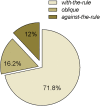Prevalence of Corneal Astigmatism and Anterior Segmental Biometry Characteristics Before Surgery in Chinese Congenital Cataract Patients
- PMID: 26912400
- PMCID: PMC4766530
- DOI: 10.1038/srep22092
Prevalence of Corneal Astigmatism and Anterior Segmental Biometry Characteristics Before Surgery in Chinese Congenital Cataract Patients
Abstract
The prevalence and the distribution characteristics of corneal astigmatism (CA) and anterior segment biometry before surgery in Chinese congenital cataract (CC) patients are not completely understood. This study involved 400 CC patients from the Zhongshan Ophthalmic Center enrolled from February 2011 to August 2015. Data on CA, keratometry, central corneal thickness (CCT) and anterior chamber depth (ACD) were measured by the Pentacam Scheimpflug System. The mean age of patients was 54.27 months, and the ratio of boys to girls was 1.53:1. The mean CA was 2.03 diopters (D), and 39.25% of subjects had CA values ≥2 D. The most frequent (71.8%) diagnosis was with-the-rule astigmatism. Oblique astigmatism was present in 16.2% of cases, and 12% of cases had against-the-rule astigmatism. The mean keratometry measurement of cataractous eyes in bilateral patients was significantly larger than that in unilateral patients. Girls had a larger mean keratometry but a thinner CCT than did boys. The CA, CCT, and ACD of cataractous eyes were significantly larger than those of non-cataractous eyes in unilateral patients. The CA, mean keratometry, CCT, and ACD in CC patients varied with age, gender, and laterality. Fully understanding these characteristics may help inform guidelines and treatment decisions in CC patients.
Figures




Similar articles
-
Biometry characteristics in congenital cataract patients before surgery in a tertiary eye care centre in Nepal.Saudi J Ophthalmol. 2019 Oct-Dec;33(4):342-346. doi: 10.1016/j.sjopt.2019.07.004. Epub 2019 Jul 17. Saudi J Ophthalmol. 2019. PMID: 31920444 Free PMC article.
-
A Novel Congenital Cataract Category System Based on Lens Opacity Locations and Relevant Anterior Segment Characteristics.Invest Ophthalmol Vis Sci. 2016 Nov 1;57(14):6389-6395. doi: 10.1167/iovs.16-20280. Invest Ophthalmol Vis Sci. 2016. PMID: 27898985
-
Evaluation of biometry and corneal astigmatism in cataract surgery patients from Central China.BMC Ophthalmol. 2017 Apr 26;17(1):56. doi: 10.1186/s12886-017-0450-2. BMC Ophthalmol. 2017. PMID: 28446167 Free PMC article.
-
Corneal complications of cataract surgery.Curr Opin Ophthalmol. 1994 Aug;5(4):98-104. doi: 10.1097/00055735-199408000-00014. Curr Opin Ophthalmol. 1994. PMID: 10147335 Review.
-
Reporting astigmatism data.J Cataract Refract Surg. 1998 Dec;24(12):1545. doi: 10.1016/s0886-3350(98)80335-0. J Cataract Refract Surg. 1998. PMID: 9850884 Review. No abstract available.
Cited by
-
Application of Surgical Decision Model for Patients With Childhood Cataract: A Study Based on Real World Data.Front Bioeng Biotechnol. 2021 Aug 26;9:657866. doi: 10.3389/fbioe.2021.657866. eCollection 2021. Front Bioeng Biotechnol. 2021. PMID: 34513804 Free PMC article.
-
Biometry characteristics in congenital cataract patients before surgery in a tertiary eye care centre in Nepal.Saudi J Ophthalmol. 2019 Oct-Dec;33(4):342-346. doi: 10.1016/j.sjopt.2019.07.004. Epub 2019 Jul 17. Saudi J Ophthalmol. 2019. PMID: 31920444 Free PMC article.
-
Height, weight and body mass index of children with congenital cataracts before surgical treatment.BMC Ophthalmol. 2017 Jul 11;17(1):119. doi: 10.1186/s12886-017-0513-4. BMC Ophthalmol. 2017. PMID: 28693526 Free PMC article.
-
An age-matched comparative study of ocular biometry parameters in cataractous and non-cataractous eyes of children in Ibadan, Nigeria.Ghana Med J. 2024 Dec;58(4):279-286. doi: 10.4314/gmj.v58i4.5. Ghana Med J. 2024. PMID: 40585517 Free PMC article.
-
An Analysis of Ocular Biometrics: A Comprehensive Retrospective Study in a Large Cohort of Pediatric Cataract Patients.J Clin Med. 2024 Aug 15;13(16):4810. doi: 10.3390/jcm13164810. J Clin Med. 2024. PMID: 39200952 Free PMC article.
References
-
- Lim Z., Rubab S., Chan Y. H. & Levin A. V. Pediatric cataract: the Toronto experience-etiology. Am. J. Ophthalmol. 149, 887–892 (2010). - PubMed
-
- Zhu X., Park T. W., Winawer J. & Wallman J. In a matter of minutes, the eye can know which way to grow. Invest. Ophthalmol. Vis. Sci. 46, 2238–2241 (2005). - PubMed
-
- Graham B. & Judge S. J. The effects of spectacle wear in infancy on eye growth and refractive error in the marmoset (Callithrix jacchus). Vision Res. 39, 189–206 (1999). - PubMed
-
- Wallman J. et al. Moving the retina: choroidal modulation of refractive state. Vision Res. 35, 37–50 (1995). - PubMed
Publication types
MeSH terms
LinkOut - more resources
Full Text Sources
Other Literature Sources
Medical

